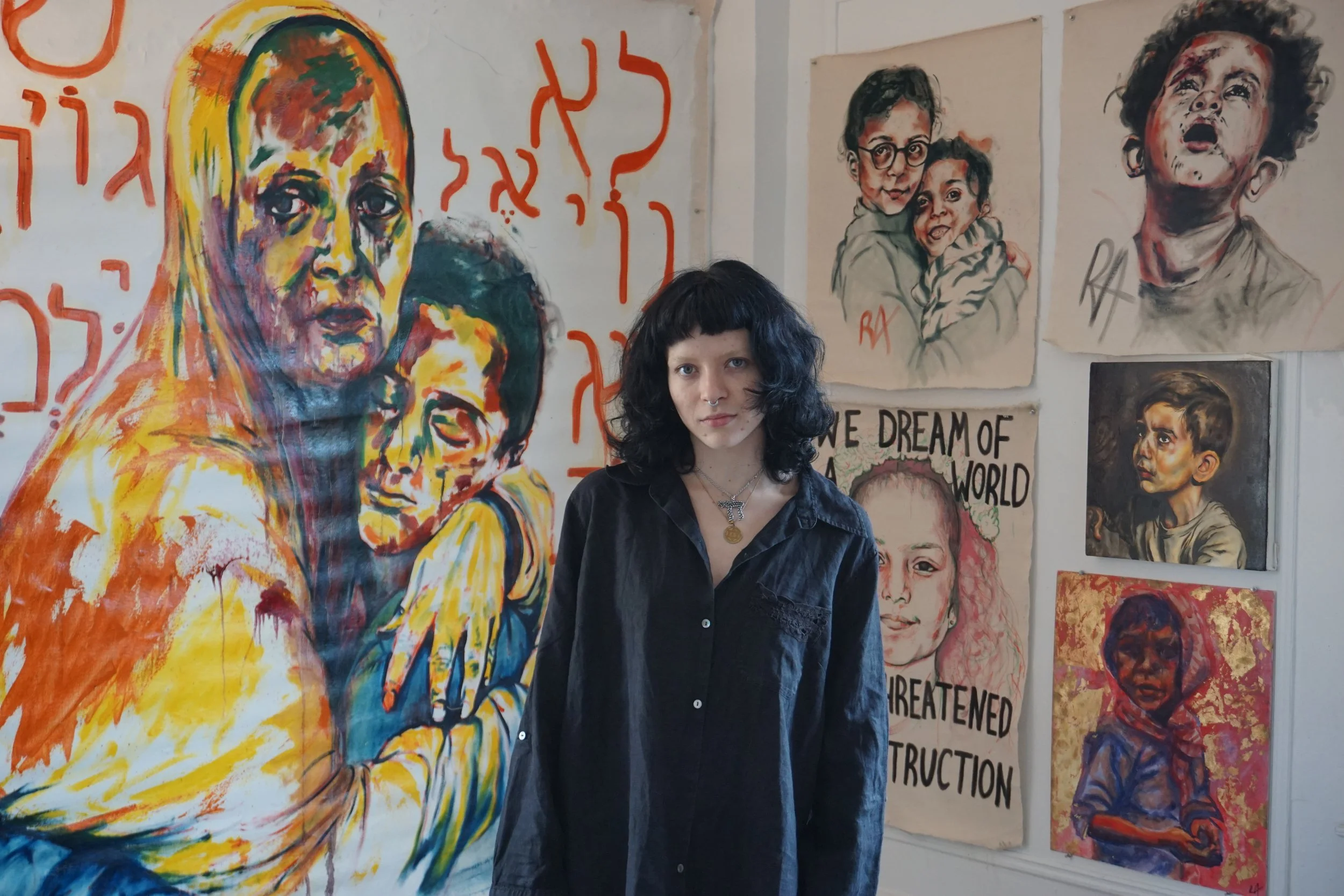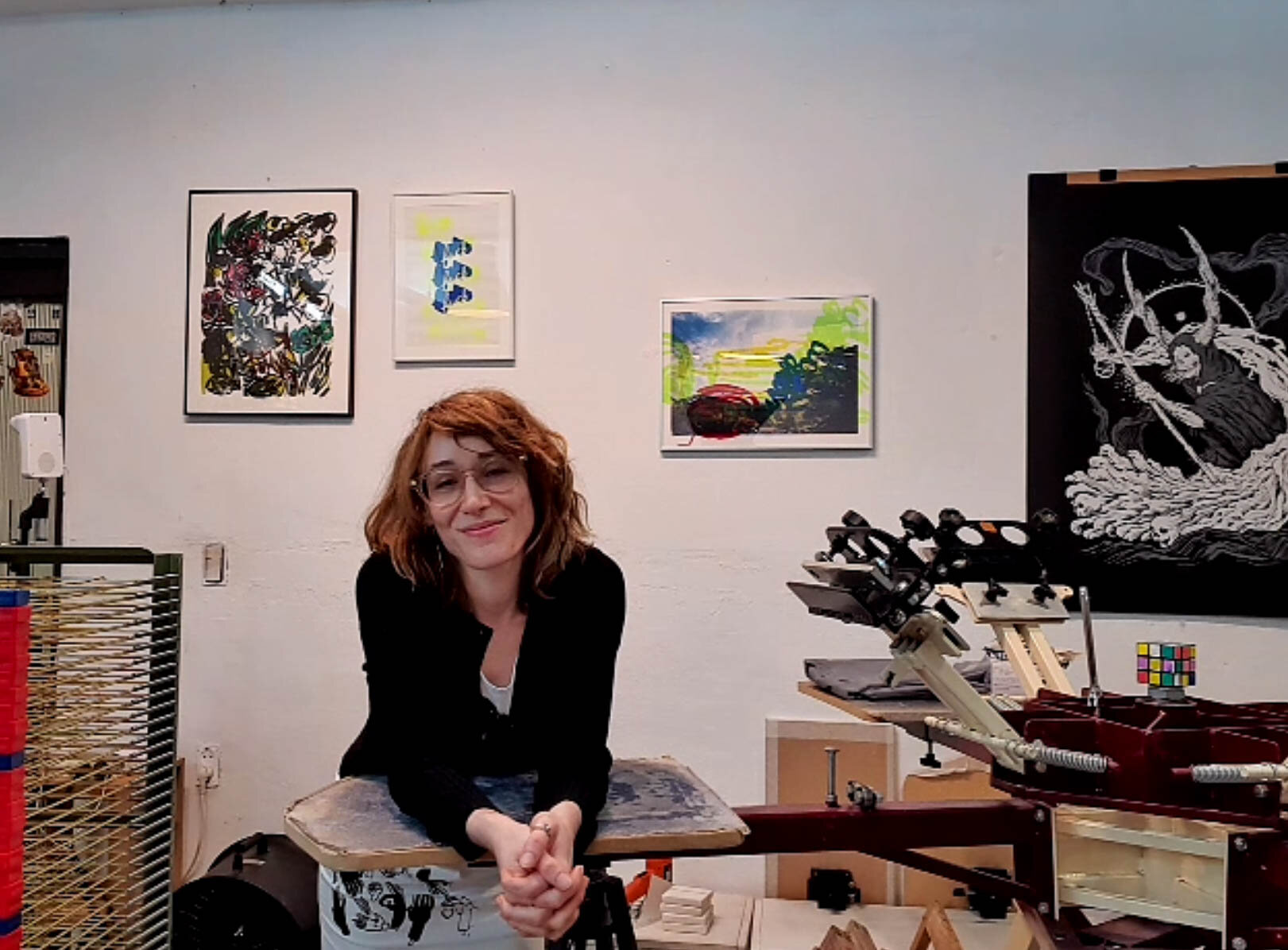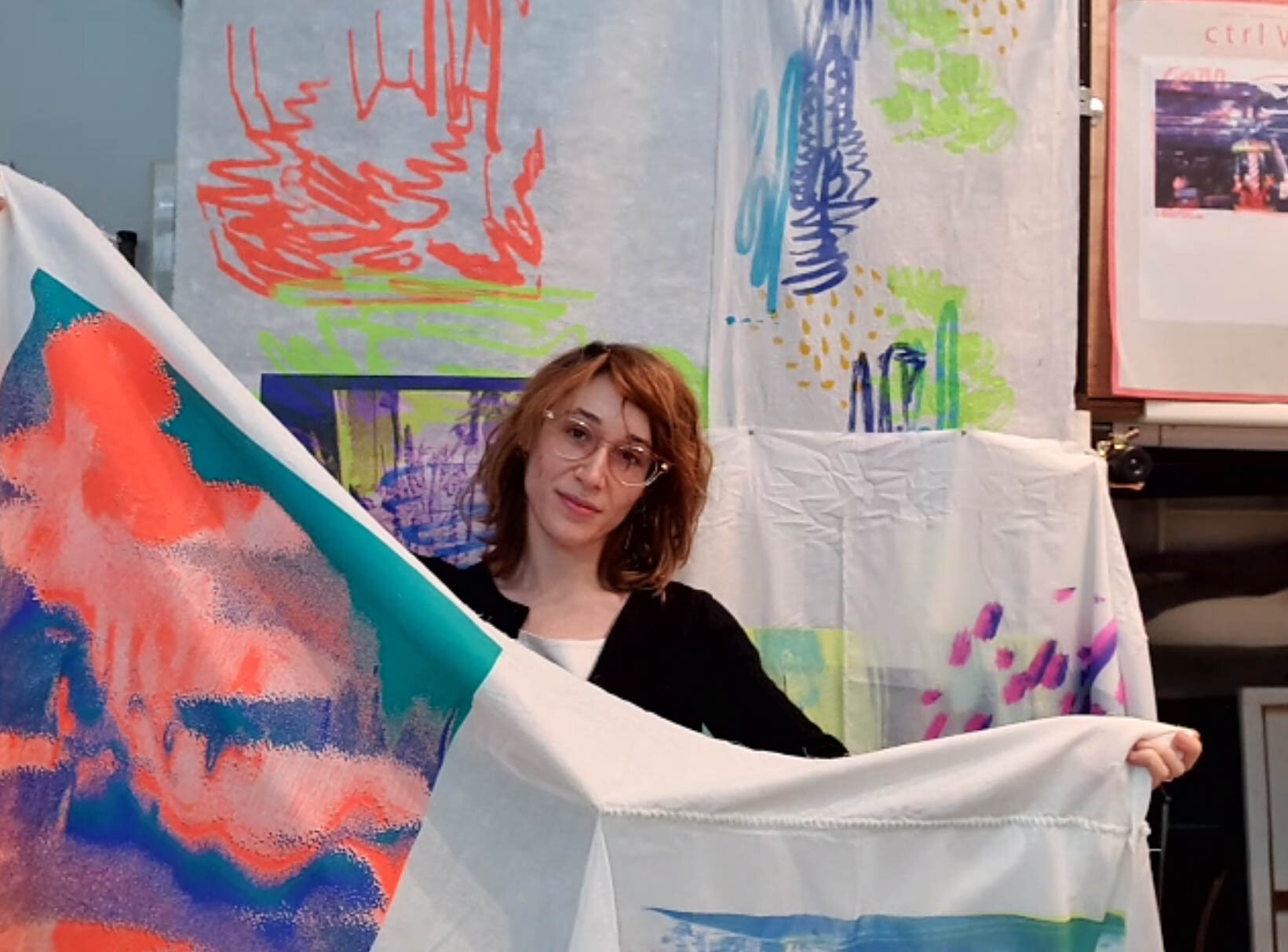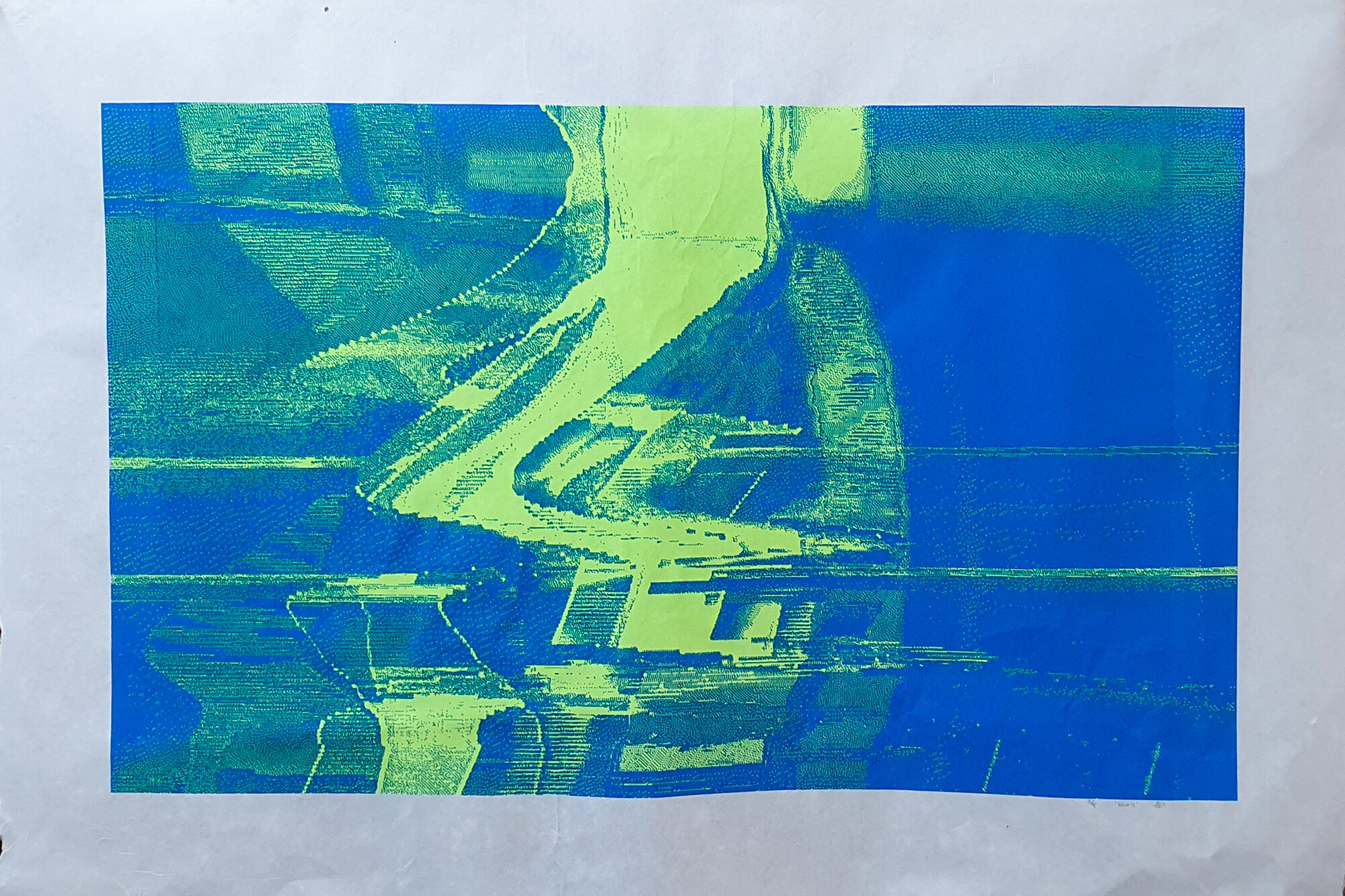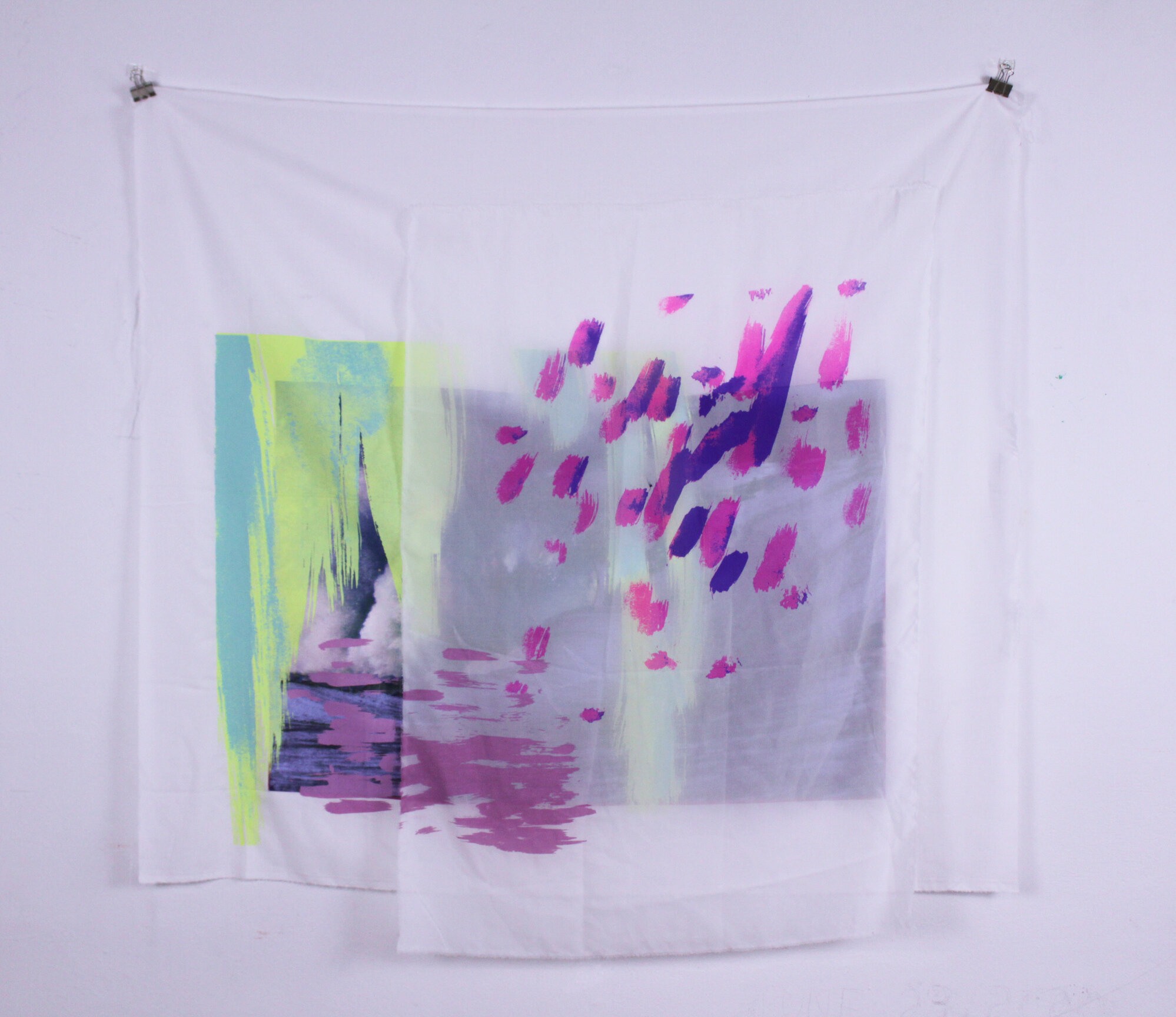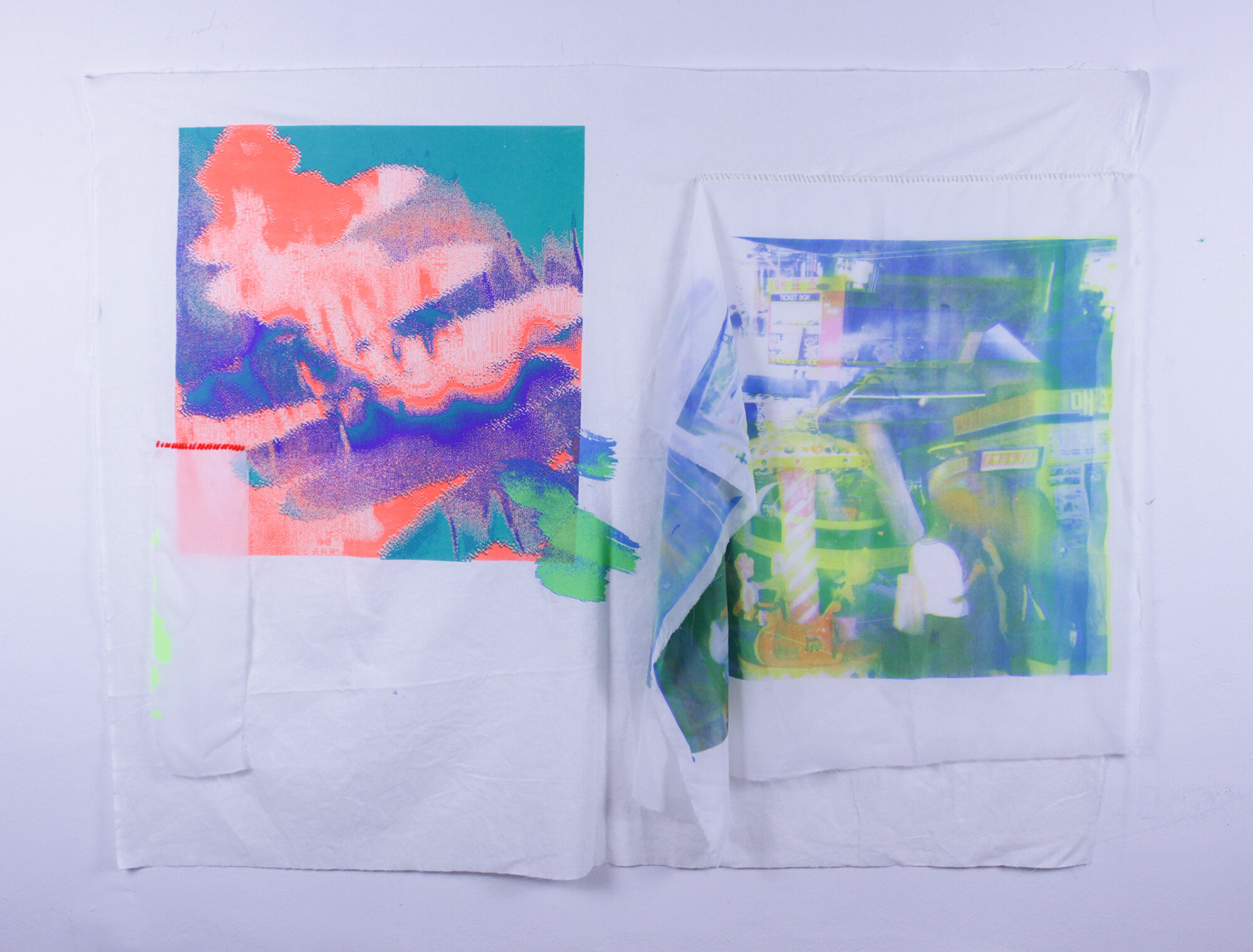Interview by Jane Ellen Loughman
Photos by Madalyn Hay
I'd love for you to first introduce yourself.
My name is Samantha Blumenfeld. I'm originally from New Jersey, USA, and I've been living in Seoul, South Korea for a little over seven years. I originally studied printmaking, but I didn't really know what I wanted to do with that. I'm a GS student, so, originally, I went to art school, which was really conceptual. But I really liked the idea of the editioning studio, where you make artwork for other artists. I didn't realize that was a possibility, so four years ago, I started a printing studio with my husband, and we were exclusively an editioning studio alongside a personal studio. From there, we were able to expand our community programming, and we do all kinds of things, like workshops, mentoring, and community classes. Between the time of being an undergrad the first time and then making my own print studio, I didn't have access to a print shop, and it was from there that I started to experiment with new media just because it was really the only thing that was accessible.
A New Man, 2019
You're based in South Korea at the moment, so what drew you to a fine art BA at Columbia? Have you been doing it online from South Korea this entire time?
Yeah, I’ve just been in South Korea this whole time. I didn't realize a non-traditional student program existed at all pretty much. I had left undergrad originally in 2010; I was slated to graduate in 2011. It was an opportunity that I didn't realize, so I took a chance. I applied [to GS] and I was really excited. I don't know how you guys do it; you're kind of like college age, but I was so immature. I was not ready for that experience. Now that I'm an adult, I feel like I really know what I want from school and how I want to finish this program.
Did the pandemic affect your experience of taking classes with Columbia?
It's been really interesting, because I work two jobs during the day, and, you know, there's the 14 hour time difference between here and the US. It's definitely not ideal; I go to the studio from midnight until 6am. It's been interesting, because it allows me to create space in my personal time, that, maybe, I wouldn't have been devoting towards art making. It really forces me to focus on that. So it’s actually been really nice to do classes online because I can still do all the things I need to do in my daily life and have access to my own studio. I'm comfortable working and experimenting here, and I don't really have to worry about what the administration might say about my own projects. So actually, it's been a really nice experience. I know for other students it's been really negative, but it's integrated into my daily life really well.
Why did you move to South Korea? Was it something that you were drawn to for your career?
I was in a long-distance relationship with my now-husband, and he’s Korean. I actually met him in high school. While he was in school, he got drafted for the Korean military, so he had to go back, and we were in that long-distance stage for a while. It got to a point where I was only really seeing him once a year. Because I didn't finish my degree, I wasn't eligible to get a working visa. So I was kind of like, well, you have to marry me. He said, sure!
Dither, 2019
You call yourself a multimedia artist, and I was just wondering, what does that mean to you? How broad is multimedia, or is it limitless?
I mean, for me, when I was in undergrad, I was majoring in printmaking and minoring in painting, hoping there would be some kind of overlap between them or that my painting process would inform my print work. I ended up struggling with this for probably like ten years, trying to make these two ideas make sense––trying to incorporate screen printing into painting and vice versa was a really big struggle. So, I moved on to new media and thought about the fact that it’s a form of information dissemination, not unlike print media. It was a little bit easier to find a connection there.
Based on the things that I've done online, there's really no limit to what you can do on the internet. Columbia is doing exhibitions online for undergraduates and the CU Arts Collective and things. I've been in a ridiculous amount of exhibitions in Croatia because everything's visual. You just send them a movie file, and then they put it in an exhibition. There’s also web-based performance, where you can broadcast to everyone. I was thinking about these ideas and then incorporated them into installations, performative installations, and interactive performances. I have some main topics in my work, and that manifests either through new media, printmaking, or a combination of the two.
Signal, 2019
I saw on your Instagram that you recently put forward some pieces to the Art Teleported 2021 Show in South Korea. Can you tell me about the pieces (“Signal,” “online”) you recently submitted for that exhibition?
I haven't really made a tremendous amount of new video work. I feel like this is the age that demands or expects video work since we're now engaging with exhibitions predominantly through online platforms. The idea of performance, or the idea of painting, they come across better in video than in stills. We have an open world of video art. For video work, I need either some really good material or some really specific concept. For “online,” I was definitely thinking about online surveillance, but I was also thinking about the way that we curate ourselves online. We're victims of surveillance, but then there's a sort of voyeuristic interaction that we have with other people we engage with online. Especially as a woman on the internet, I think there's an extra level of expectation and self-curation for how you create an online persona.
Is there anyone or anything in particular that inspires your new media work?
If you're doing new media, it’s hard to not bring up Nam June Paik, a Korean media artist; he’s the one who created the idea of TV installations. His work is everywhere in Seoul. I think what he did was, and is still, really cutting edge. It's timeless––the idea of integrating these new media technologies into daily life or into spiritual experiences is still something we're talking about today. So I'm definitely interested in his work as far as videos and installations go.
As for the glitch art, it's really interesting, because the whole community is really crowd-sourced. You can find tutorials for any kind of skill that you're really interested in learning and there's really nothing stopping you from acquiring and developing a new visual language. Aside from that, I feel like John Berger’s Ways of Seeing [inspires me]; how we see, interpret and understand art, what it means to exist in this super, super ultra-commodified space and how there is a consistent reference to art and art history.
How did the pandemic affect your life, artwork, and your work ethic?
I guess it gave me a little bit more incentive to go back onto the web as a platform. Obviously, there's less in-person exhibition opportunities now than there were before the pandemic. Now it's not so much about creating art as it is about creating content. The idea of branding as an artist is part of this; creating something tangible to post and just being able to utilize the platform in a performative way or to even use it as its own medium, I guess. The pandemic is definitely pushing me more in that direction.
tvagif16, 2017
I’ve been messing around with AR (augmented reality). A lot of my work is based on these animated gifs of abstract artwork. I was thinking about how it'd be really interesting to be able to integrate them into a real-life experience so that it becomes a universal experience accessible in people's real, lived experiences. I am just starting off with AR, so there's a huge amount to learn, but I'm currently creating some virtual objects based on the same pieces because a lot of my work is a dialogue with itself. It’s very self-referential; I'm looking at this particular frame from this video or this animation, and then turning it into a screen print or turning it into an AR sculpture. Hopefully, this summer, I'm going to start doing some 3D printing. There's going to be a translation from the AR, from the internet to a new kind of object. So I'm really excited to just be able to utilize new technologies and experiment.
Can you tell me more about your performance art piece ‘Art Object’ from 2018?
That was definitely one of those pieces that, after really reflecting on Ways of Seeing, I was like, I have to make this. It was also inspired by the idea of art dissemination and art ownership, and what it means to be able to view a piece of art in your own house as a sense of ownership. I started to think about this idea of virtual ownership in relation to the female image. We have all these famous works of art with women pressured to fit into a certain mold or certain set of standards. I’m looking at classical examples from art, and then it was up to the audience or the viewer to mold me into this perception of this idealized Venus. I almost got thrown off Facebook for that, because I did a Facebook live stream and a bunch of people reported me for pornography. I'm actually wearing a very light pink top and leggings, but they just didn't listen to reason. I've never been, I guess, censored in that way before. So I was just like, this is dumb! It's just classic artwork.
Art Object, 2018
I was totally enraged, like absolutely, unbelievably infuriated. I'm not nude, and I'm utilizing these ideas from Renaissance art. These are examples of art that people think of when they think of the female nude, these depictions of Venus by all these different artists. It's this idea of what the Guerilla Girls say: the only way to be a woman in the Met is to be nude, right? So we're seeing this, we're being told this is the default. It's fine, it's whatever. But then the idea that if I'm utilizing or appropriating these images through a little bit of a different lens, then I'm wrong. And so it's the same bullshit, right?
Is there any one piece or group of work that is your favorite? Or is that just impossible to pick?
new-gif-1c, 2020
It's hard. When I was doing exclusively new media, I was at a really specific point in my life, emotionally and maturity-wise; I was trying to understand myself. So, projecting this avatar or this facsimile of the kind of person I wanted to be allowed me to experiment and play, even if I missed out on that chance when I was younger. I feel there's some of that work that is really superficial and visual. They’ve been called “screensavers” by art critics. I feel really connected to that work because I did so much; I generated thousands of images for that body of work. And then I started to go back into painting as I was dealing with some personal things because I thought oh, this new media isn't really relevant for me anymore. And then I moved more into screen print, and then more into experimentation, and then more into incorporating or expanding what could be a screen print, pushing that process in a couple of different directions. So I guess I really like the work now. Now, I'm starting to experiment with some textile installation that also brings in screen printing. There's just a lot of different things going on. But I think that where I'm at right now makes sense for this moment.
Why were you drawn to art as either a hobby or as a career, or both?
The abridged answer is because my parents didn't want me to do it, and I hated my parents. But art gives you a really unique opportunity to really hear people's stories. It’s an interesting way to see through the lens of someone else, to really try to engage and struggle with some of the things that they're struggling with. Using the internet, I wasn't playing online games, but I was always in chat rooms; I just enjoyed hearing people talk and see what they had to say. And nowadays, it's a changed platform, but I'm still doing the same thing on the internet that I was doing since I was nine. I think art channels a lot of that similarly.
Have you found a community for yourself in Seoul from your printmaking studio or from making art in general?
With our printmaking studio in Seoul, we are in touch with a few other printmaking studios because they're all connected. I wouldn't say it's a niche form of art, but it's very particular. There's a really specific process that you have to do for print. A lot of studios aren't really equipped for it. We are in touch with a lot of community studios in some way, where we work and collaborate together. There's that general printmaking network going on. The other side of it is the people in our studio––we have studio memberships. The one thing I really like about printmaking is that it's usually a communal practice. You're sharing a studio space, you're working with others, or you're collaborating with others. We've done everything we can to build that community here. So we have a lot of screen printers that come from all different types of artistry backgrounds. They collaborate and do exhibitions together, and you know, they become friends. It’s really cool then to see how it affects their practice, and then what projects they do moving forward.
left to right: blur11, 2020. Wave Vr 2, 2020. Ocean Vr 2, 2020.
If you could do anything you wanted, a dream piece, installation, exhibition, anything that you may be thinking of doing or want to do soon or you can't do yet, what would it be?
Yeah, there's kind of a new body, and it's related to some of my textile work. I got sidetracked because of school. A lot of the new media stuff and earlier screen printing stuff that was glitch, I refer to as “the mind mimetic.” It’s a metaphor for the way that we approach our own personal narratives and there are two recurring motives that we return to, regardless of where we're at in our lives. I'm really interested in this dissemination but within a macrocosm of the self or the psyche. And so, now, I'm really interested in the internet tactile––how can we make the internet a tactile, real experience? So, incorporating augmented reality into 2D work––but not being completely reliant on it––to make things that people can touch and really experience and perceive; I'd essentially like to make an exhibition dealing with that.
Are there any new projects you want to plug?
Oh, well, there is a separate project that I'm working on, but I feel it's going to be more of a long-term project. I ideally would like this project to take a minimum of ten years. It’s more of a personal archive of the screen printing work I've made. I have these prints on traditional Korean paper, and they're almost two meters long. They're very unwieldy in size, but I have a series of them. I realized this was a transitional body of work that I was making, so it was this idea of incorporating painting into screen print, incorporating new media, and then creating a screen printed collage with 12 or 15 layers. I have a couple of pages, these giant sheets. I'd like to continue this idea of the archive, and then essentially make these into a very small edition of gigantic books. This is something I'll just be working on in the background while I'm doing other projects I'm more focused on. Ideally, I'd like to have a document that shows all of my artwork in a way that it becomes the artwork, that challenges the idea of what an edition is, which is also something I'm really interested in as a printmaker.
Where else can we find your work?
Instagram: https://www.instagram.com/roribleu/
Website: https://srb.neocities.org/




